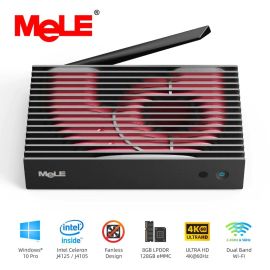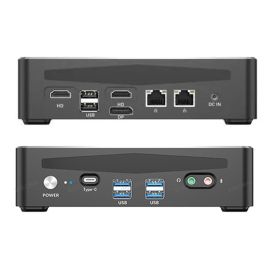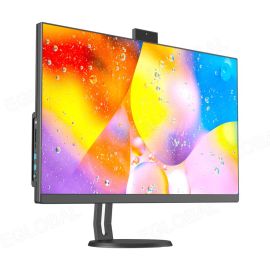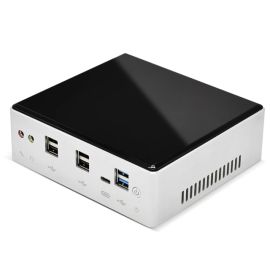
What's Inside
- What is a Desktop PC?
- Advantages of Desktop Computers
- Disadvantages of Desktop Computers
- What is an All-in-One Computer?
- Advantages of All-in-One Computers
- Disadvantages of All-in-One Computers
- All-in-One vs. Desktop Computers: Which is Right for You?
Debating between buying an all-in-one vs. a desktop computer? Read our comprehensive guide on the Advantages and Disadvantages of each to help decide which is worth your money.
What is a Desktop PC?
A desktop PC houses all its components within its case, or tower, including an independent CPU, GPU, RAM, motherboard, fans/cooling, disc drive(s) and PSU. Users typically place it either on top of or underneath their workspaces.
The monitor, or display, is separate from the tower and can be connected to it via HDMI and USB-C (for newer desktops), and VGA and DisplayPort (for older desktops). You may need to purchase your PC peripherals including the mouse, keyboard, external speakers, and monitors separately.
Advantages of Desktop Computers
- Customizable– Part of the magic of desktop PCs is the ability to swap out any component easily, provided it’s compatible with the other parts in your build. Rather than needing to buy a whole new PC, you can replace what you need to replace and upgrade only as necessary. This is great to have if you need a better graphics card to play the latest games or run out of internal storage and need a bigger SSD. Since the monitor is independent from the tower, you can also upgrade and replace it at will, which is great if you’re looking to switch to 4K resolution monitors, for instance.
- Repairable—If anything breaks down with a desktop PC, it’s very easy to get into the case and fix or replace the malfunctioning component. With all-in-one (AiO) computers, it can be hard to access components, or the CPU/GPU may be soldered onto/integrated with the motherboard, making it nearly impossible to replace or repair. If something breaks, you may end up having to buy a whole new AiO. If you’re willing to repair or replace your desktop PC components yourself, this will certainly save you money in the long run.
- Affordable—On top of saving money on maintenance, desktop PCs cost less than AiO computers. This is because AiO computers use smaller components designed for mobile computers to fit all their components into the back of their monitors, which requires additional development and engineering resources. There isn’t nearly as much wasted space with an AiO computer than with the spacious case of most desktop PC, although the monitor of an AiO is thicker than a normal monitor, typically.
- More powerful—While a desktop PC power does have a lot of dead space in the case, this also allows for fans and other cooling solutions to circulate air and keep your components cool. Components like the CPU, GPU and memory are often limited by what’s called thermal throttling, since they will release a lot of heat under heavy workloads like 3D rendering, AAA gaming, querying large databases and data mining. Keeping them cool is essential to peak performance.
In an AiO computer, your performance is limited since your ability to cool your components is limited. The bigger case of desktop PCs allows for the biggest and best components available. Also, AiO computers tend to have their components soldered onto their motherboards to conserve space. Integrated (soldered-on) graphics cards are smaller and don’t dissipate heat as well as discrete (separate) graphics cards, for instance.
Disadvantages of Desktop Computers
- Everything sold separately—if you’re purchasing technology for your organization, it’s a lot easier to order all-in-one computers since you don’t have to worry about purchasing the monitor, keyboard and mouse separately. In fact, you may not need the keyboard and mouse at all since many AiO computers have touchscreen monitors as well. If time is of the essence and your organization doesn’t acquire top-of-the-line computing power, AiOs may be the better option.
- Takes up more space—Time may be of the essence, but space can come at a premium, too. In tighter quarters like school computer labs or a medical waiting room, a bulky, full-sized desktop PC could be a hinderance to productivity or simply won’t fit. All-in-one PCs leave a smaller footprint, leaving space for more than just your computer on your desk. Plus, having less desk clutter and minimal distractions can help you focus more on the task at hand and make for a more Zen, comfortable work environment. If you’re still set on a desktop PC and want to maximize space, be sure to investigate thin client PCs, which have smaller form factors.
- Harder to move—Since everything is independent with desktop PCs, there’s more to lug around or break, or get lost in the shuffle, such as monitor cables and speakers. If you’re a digital nomad or planning to move soon, it may be worth the reduced stress and play-and-plug nature of a AiO vs a desktop PC". Also consider a laptop if portability is your primary concern—you can get much of the same capabilities as an all-in-one, but you may have to pay quite a bit more, depending on how souped-up you want your laptop to be.
What is an All-in-One Computer?
An all-in-one computer, or AiO, combines the separate tower and monitor of a typical desktop PC" setup into a single piece of hardware. It is no different from a desktop PC in terms of basic functionality. There are several advantages AiOs have over desktops.
Advantages of All-in-One Computers
- Easier to transport-Lugging around both a PC tower and display (or multiple displays) can be cumbersome. The beauty of the AiO computer is the fact that it is relatively small, light and simple—the average AiO weighs as little as about 12 pounds and up to 30 pounds. You also don’t need to worry about all the cables and the cable management that comes with them.
- Compact-AiOs are a great option if you’re lacking in desk space. Their smaller form factor when compared to desktop PCs make them ideal for reducing clutter so you can better focus on the task at hand. This makes them great for retail, healthcare and education applications, as well as home users strapped for space.
- Everything you need-AiOs take the guesswork out of purchasing a PC. Everything you need is in the box—you may not even need a keyboard or mouse if you purchase a touchscreen AiO. You also don’t need to worry about buying a docking station or the cables to connect your laptop to external monitors like you would with a laptop. If you purchasing PCs for your organization or don’t feel the need to custom build your PCs, this can save you a big headache.
- Touchscreens-Many users prefer an intuitive touchscreen interface which many AiOs with Windows provide. Their displays are large on average, making them great for applications such as retail kiosks or interactive learning stations.
- Aesthetics-AiOs are designed to be visually appealing. From their sleek chassis to minimal cables, AiOs have a clean, sleek look and small desktop footprint appealing to users looking to spruce up their spaces.
Disadvantages of All-in-One Computers
- Can’t be modified or repaired easily-With your standard desktop PC, it’s easy to pop open the case and replace faulty components or upgrade to a faster CPU, for instance. On the other hand, AiOs are not designed with modification in mind—you can’t easily get inside the device, and even if you do, you may find that many parts are soldered onto the motherboard, or the components you purchased are too large or aren’t compatible. Plus, you may void your warranty in the process. Reportedly you can upgrade the RAM and storage of some AiOs, but you may be best off leaving this to a professional as to avoid unintentional damage to your machine.
Keep in mind AiO components are specially engineered to fit within its compact confines. In this way, they are like laptops, both in component size and difficulty in upgrading. - More expensive-If you’re looking for the most capable PC for your money, an AiO is not be the way to go. Building a custom or a preconfigured desktop PC generally will give you similar specs for less. Plus, all computers eventually grow outdated and you’ll need to buy a new AiO to upgrade, whereas with a desktop, you can just replace whatever you need to and run the latest, cutting-edge software or upgrade your internal storage as need be. For this reason, the AiO may cost more in the long run, since they’ll most likely last about 5-10 years depending on how well you take care of it.
- Not as powerful-AiOs are designed with the average PC user in mind and are more than capable of meeting the computing needs of most users. However, if you’re a graphic design professional or software engineer in need of extra processing power or a heftiergraphics card, an AiO probably won’t cut it for your needs. The limited amount of space in the case minimizes the ability of AiOs to cool their components, which restricts your ability to overclock your CPU, for example. If you’re looking to do any modern gaming, an AiO is not the best choice.
All in One vs. Desktop Computer: Which is Right for You?
If you’re looking for the easiest and most cost-effective solution, a traditional preconfigured desktop PC is the way to go. Want to play the latest games and have the most powerful system possible? A custom desktop is your best bet. However, if you’re looking to have the most streamlined, no-frills, plug-and-play desktop workspace, an all-in-one PC may be just what you’re looking for.
Source: https://www.cdw.com/
















